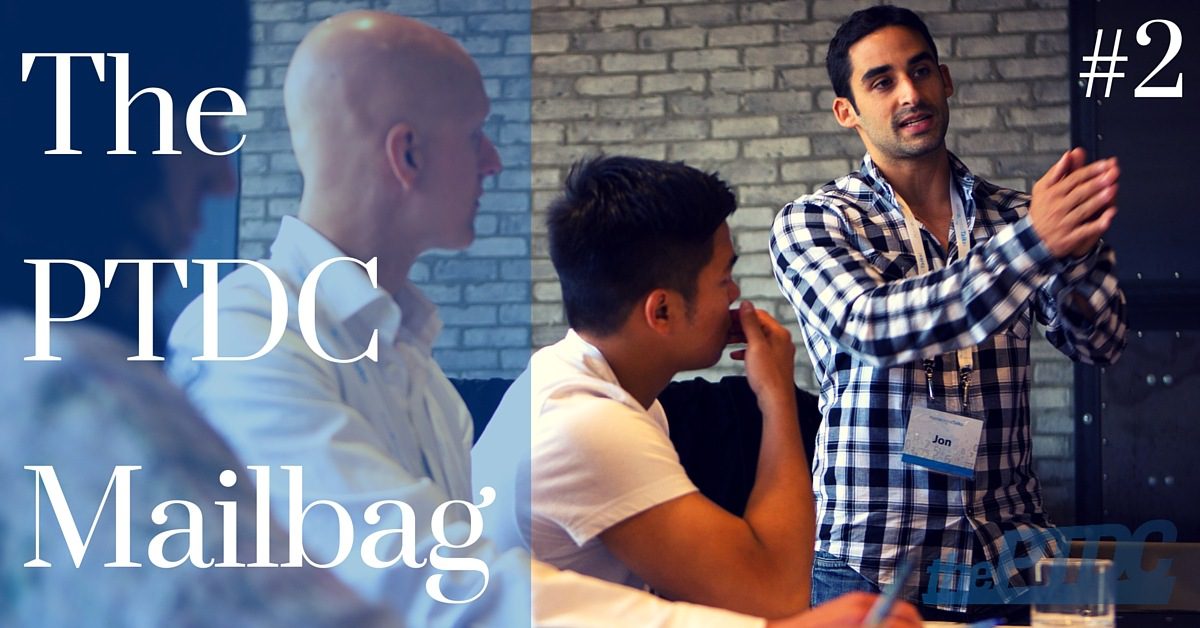I get tons of questions all the time.
Rather than just hitting reply and having it exist as an email response that only one person could see, I want to share my fully thought-out responses with you, the wider PTDC community. And so, I present to you The PTDC Mailbag, a monthly feature where I'll throw together a mixed bag of your questions and answer them more in-depth.
In this edition, I answer the following questions:
- How do I expand my business on social media and gain more followers (without "buying" them)?
- How do you overcome the feeling that you don't know enough or aren't 'qualified' to train someone?
- What is the best way to keep clients on, and not let them drop off?
Without further ado, here we go.
1. How do I expand my business on social media and gain more followers (without "buying" them)?
- Kristin A.
Hey, Kristin. First, I'll clear up a misconception: more followers aren't necessarily good. This is coming from a guy with 220,000+ Facebook fans. It's not just about the number.
You need deeper and more engaged relationships.
In fact, larger numbers on Facebook can hurt you because organic views--the views that you get without paying--largely depend on a high percentage of your audience that is actively engaged with your brand. So, buying or getting a lot of low-quality followers can actually mean that your good followers won't see your stuff.
In other words, your question should be: How to get more of the right kind of followers that want to buy your products and talk about you?

To answer that question, I've conveniently already written an entire book about this called Viralnomics: How to Get People to Want to Talk About You. The following is just a snippet of what I talk about in greater detail within the book:
The reality is that people who aren't yet interested in you or what you have to offer at this moment are close to impossible to access through organic outreach efforts. Their social feed moves too fast; the "reverse search" (or the filter bubble effect) filters out what they see and don't see based on a complex data matrix of what and whom they like.
This simply means you need to change your target when you develop your social media content (Facebook post, Instagram picture, etc.). Your goal is not to convince people of something they don't know about. Instead your goal is to appeal to the people who already agree with you.
This is a small but influential difference.
So take a minute to think about what you like and don't like, as well as what your audience likes and doesn't like. That's what you talk about. Be the microphone for your audience's pre-existing notions and opinions of how the world should be, and they will share you with their friends and bring you more followers.
When you're first starting out, the best thing to do is to expand your friend network on your personal page. After you've decided your ideal audience, you can figure out a few key figures that already serve your ideal audience. They don't have to be super famous nor influential, but small to medium bloggers with a good audience.
For example, if your audience was fitness professionals, I'd be a good target.
The next part involves actual work: create a new account under a pseudonym and make it your actual personal account. Tell your close family and friends to connect with you there, if you'd like. Add those influential people as a friend to your personal account. In fact, you should add 20-40 people as friends a day. Go through the friend's list of this person and add their friends that look like professional contacts.
Be unabashed about it.
This is exactly how I built up my initial network years back. It was nothing fancy. I simply pressed "Add as friend" on other bloggers personal accounts. Then I went through their friend's list and pressed "Add as friend" for people who looked like a personal trainer or said they were a personal trainer on their profile. Now I'm here talking to you.
For more information on expanding your audience, I urge you to read:
- Viralnomics: How to Get People to Want to Talk About You (On Amazon in paperback, Kindle, and Audible)
2. How do you overcome the feeling that you don't know enough or aren't 'qualified' to train someone?
- Murray
Murray, you're suffering from impostor syndrome. It's the mindset that you're "just a fraud" and that you'll eventually be found out. We've all had it at some point; some of us still have it to some extent.
In any profession involving mastery, like personal training, this impostor syndrome is very real.
Simply, there's no good way to measure absolute effectiveness in training: a client can probably be happy and get good results from about a thousand different programs, whether you trained him or not. So when you combine that with inflated egos within the training industry, the result is a particularly high barrier for new trainers to overcome this syndrome and get their feet wet, so to speak. I feel for you.
However, an ego is necessary for a trainer to sit in front of a client, listen to the client's insecurities (stuff he probably doesn't share with many people), say "I can help you with that", and take his credit card to do so. The job self-selects for it. When you go online, for example, you'll see coaches professing to be the experts who hold the "secrets" to fat loss. In short, you need to develop an ego, but I'll let you in on an industry secret:

Feeling like an imposter is why most trainers are afraid of sales
None of us knows what we're doing.
We have good guesses, and those of us who actually care are always striving to get better. Personal training is a profession that requires mastery, where every practitioner is acting on hunches and working hard to figure out what works in terms of coaching, physiology, and biomechanics. We hope we hit the right buttons to help our clients get results, and most of the time it works. But basically, we're all making things up as we go along.
I confess these things in the hopes that you gain the confidence to push forward and strive for mastery. That's the best you and any of us can do. If you're always getting better, you'll be one step ahead. Approach every day with confidence knowing that, on that day, you know more than you've ever known from the day before. Then six months after that you recognize how much of an imbecile you were.
Of course, none of this means that you are allowed to be irresponsible. Here let me share how you can strategically build up a diverse level of knowledge for working with different clients without overwhelming yourself:
- Figure out whom you are qualified to train and become confident in that. Generally, you should be training the one kind of client whom you feel are most qualified to train. People like yourself or people who are going through similar experiences that you can offer insight on and help with.
- Gradually expand to different people. As you build your base of knowledge, I recommend only taking on people like you, in addition to somebody from a different population. This way, you have plenty of time to research the other type of person during your downtime. Once you become confident in the second population, and later, in training both of them, you can take on a third type of client from yet another population. Repeat this process.
3. What is the best way to keep clients on, and not let them drop off?
- Candace W.
I'm glad that you asked this question, Candace, because keeping clients, or client retention, is the secret to the best trainers in the world. We've covered it extensively here on the site (like here and here), but it's not a sexy subject so the articles never spread around too much.
Simply put, retention is all about relationships. Clients come for the training, buy for the people, and stay for the relationships that are built.
I'll go over the two main elements here: rapport and gifting.
Building rapport is not one of those things that you just do and check off on a piece of paper. You have to be purposeful day in and day out to make your client the center of attention and make them feel important (because he and all your clients are).
I use six ways to establish rapport. I first came across these six ways from Chet Holmes in his book The Ultimate Sales Machine.
- Ask great questions
- Have a sense of humor
- Commiserate
- Be empathetic and care about them
- Find the common ground
- Mirror
I go into detail of how to specifically apply each of these six concepts to training in this article.
The second important element of building a solid relationship is giving gifts, but they're typically done really badly:
- Christmas cards and birthday cards for clients are nice, but those times are just about the worst time of the year to send them. You are much less likely to stand out. Worse, you create a culture of expectation. This is dangerous because if you forget one year, then whoops.
- A bottle of wine is the worst gift that you can give. It's either not wanted and re-gifted, or drank and forgotten about.
- A free session (or something similar) in exchange for a referral is a terrible idea.
There's a reason I think those are terrible gifts. In my book Ignite the Fire, I discuss at length how motivation works. Most notably, I advise that intrinsic motivation is often decreased by extrinsic motivators.
Here's an example of what I mean:
Last week, I was at the Motivate Summit in Toronto, where my friend and a fellow trainer, Benjamin Pickard, was also in attendance. Benjamin owns a small training studio, and he told me about the gifts he'd sent two of his clients for their referrals. He had two custom-made coffee mugs, which included the client's name and said "powering {client's name} deadlifts."

The perfect client gift - Keep on fueling those client's deadlifts Ben!
Perfect.
See, a great gift has a few elements:
- It's personal and meaningful. Don't give somebody something with your company's logo on it. Put their name on it. Always.
- It's something that maximizes impressions. A coffee mug from Benjamin's example is used every day, meaning you're thought of every day. That leaves a much better impression than gifting a bottle of wine.
- It relates somehow to the service that you provide (optional).
Instead of sending Christmas or birthday cards, I like sending random cards in the mail. When was the last time that you got a random hand-written postcard or letter in the mail from a friend or person whom you do business with? Has it ever happened? Bet if it did, it would stand out.
Wherever I am in the world, I buy 5-10 postcards, choose members who are doing great work in their gyms and communities, write a postcard, and put it in the mail for them.

A group of postcards that was sent to PT-Society members from my home this past winter in Nosara, Costa Rica
You can do something similar: buy a bunch of nice cards (30-40 should suffice). Whenever a client has a success in the gym, make a note of it on your clipboard. Let's say that she nails a deadlift goal, for example.
When the client leaves, write a card saying how awesome it's been to see her get stronger and you were so happy to see her nail her deadlift. Sign the card. If you work in a gym, say that the entire team has loved seeing her get stronger, then have the entire team sign the card. Put it in the mail.
"But Jon, can't I just give the card to her the next session?"
Yes, you can, but you shouldn't. The most special part about this is doing something different.
Put it in the mail. You can afford the stamp.










